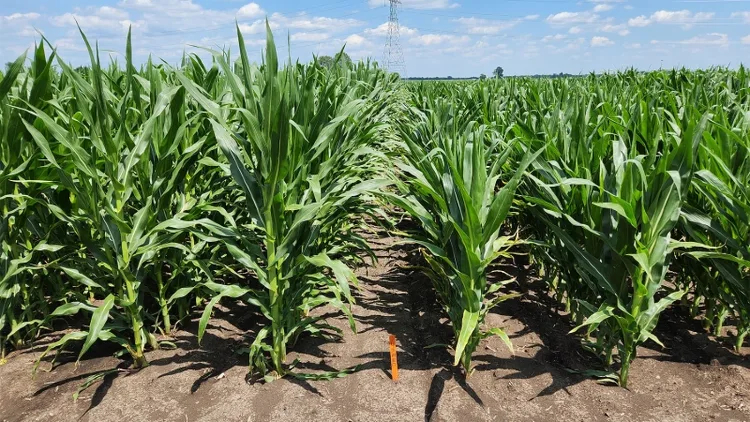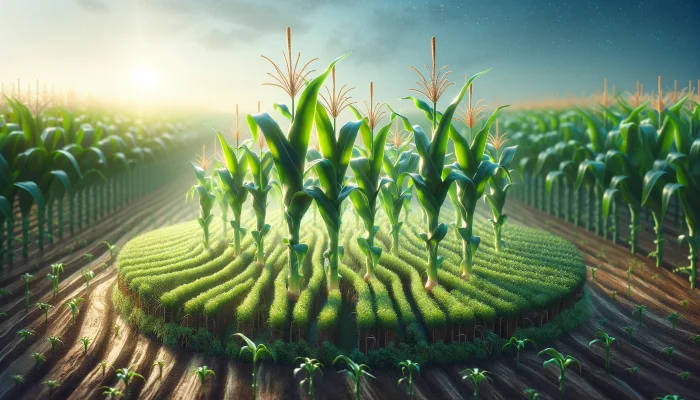Not that long ago, farmers selectively bred corn plants to make them taller. But, just like bell-bottoms and voice phone calls (FaceTime is still a phone call!), even agriculture can, at times, be a cyclical industry.
The latest agricultural development growing in the U.S. corn industry with multiple major seed and genetic companies involves innovative “short-stature” corn hybrids. These hybrids, markedly shorter than traditional full-stature varieties, could usher in a new era of farming efficiency and productivity. Standing 20 to 24 inches shorter, they bring potential benefits that are significant for farmers, consumers, and the environment alike. We’ll get into those below.
A New Era for Corn Farming
The shift to these compact corn hybrids promises several advantages. Their shorter stature leads to increased lodging resistance, making them sturdier against environmental stresses. They’re also more tolerant of higher plant populations and narrower rows, which can lead to more efficient land use. Additionally, their height provides easier in-season access for agricultural equipment, simplifying the application of fertilizers and pesticides.

Pioneering Research at Purdue University
To understand the implications of this agricultural shift, Purdue University, in collaboration with Bayer CropScience, conducted extensive research. In 2023, their trials compared short-stature and full-stature corn hybrids, noting a significant reduction in plant height – 67 inches for short-stature corn compared to 86 inches for traditional varieties. The average ear height was also lower, making harvesting more manageable.

Despite these differences in stature, there were minimal differences in total above-ground plant biomass, with short corn and conventional corn showing similar weights. The compact nature of short-stature corn results from tighter spacing between nodes below the ear.
Yielding Promising Results
In terms of yield, the short-stature hybrids held their own. Purdue’s research across various Indiana locations demonstrated that these hybrids could match or slightly trail the yields of full-stature hybrids in the same environmental conditions.

Impressively, in some research treatments, yields of short-stature hybrids exceeded 300 bushels per acre. They maintained strong average yields, ranging from 240 to 260 bushels per acre in northwest Indiana and 250 to 300 bushels in central Indiana.
Adaptation to High-Density Planting
These hybrids showed a higher tolerance for increased seeding rates and narrower 20-inch row systems. Increased seeding rates, from 34,000 to 50,000 seeds per acre in narrow rows, still resulted in continued yield increases. This suggests a remarkable potential for these hybrids to thrive in even higher-density planting scenarios. In 30-inch rows, the agronomic optimum seeding rates for short-stature corn were on average 6,000 to 8,000 seeds per acre more than traditional full-stature hybrids.
More To Discover
- Al Dhafra Solar Farm: The World’s Largest Single-Site Solar Farm Shines On The UAE’s Renewable Energy Ambitions
- Pioneering Anti-Aging Pill for Dogs Begins Trials, with 11-Year-Old Whippet Boo Leading the Pack
- Behind The Scenes Of How Tyson, JBS, Cargill, and National Beef Use Consolidation And Auctions To Control The Beef Industry
- The World’s Groundwater Crisis and the Pockets of Hope Defying the Trend
Conclusion
The advent of short-stature corn hybrids is more than just a new chapter in agricultural science; it’s a paradigm shift in crop cultivation. Offering a blend of robustness, yield efficiency, and environmental adaptability, these hybrids could significantly impact farming practices, food production, and sustainability. As these hybrids move closer to widespread adoption, they hold the promise of a more efficient, productive, and environmentally friendly future in agriculture.




















